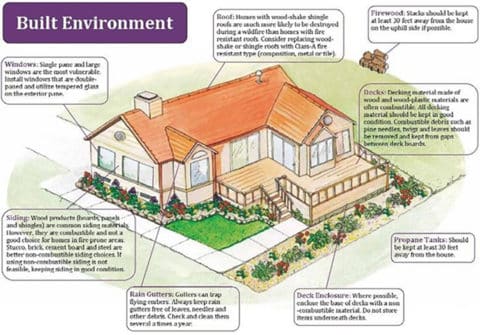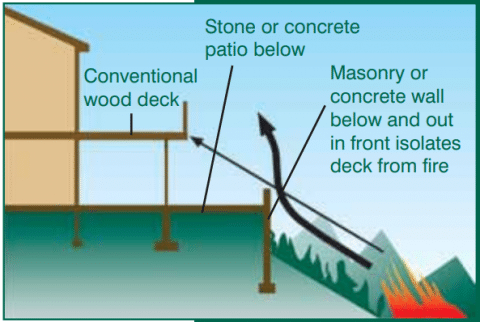When considering new construction or updating current home construction, residents can make choices to improve the survivability of your structure during a wildland fire. Risk reduction is every resident’s responsibility.
Steps to protect homes and structures from ignition, aka Home Hardening

The Home Ignition Zone (HIZ) includes the structure and the first 100 feet immediately around the structure. West Regional Wildfire Council (WRWC).
Two factors have emerged as the primary determinants of a home’s ability to survive a wildfire – the quality of the defensible space and structural ignitability. Together, these two factors create a concept called the Home Ignition Zone (HIZ), which includes the structure and the space immediately surrounding the structure. To protect a home from wildfire, the primary goal is to reduce or eliminate fuels and ignition sources within the HIZ. Click on the image “Built Environment” to enlarge.
During a wildland fire, most home ignitions result from embers or firebrands (chunks of smoldering material) landing on flammable material on or immediately adjacent to a structure. Embers may travel over a half mile from the main fire. Other sources of ignition are direct flame contact or radiant heat. To best prepare for a wildland fire, home ignition sources should be identified and eliminated or diminished.
In addition to building materials, it is important to keep up with annual maintenance to your home and your grounds. Risk reduction is an ongoing job.
Building materials alone are only one-half of the mitigation necessary to give your home the best possible chance in the event of a wildfire. The other half is reducing fuel loading in the land immediately surrounding your home and your community.
Your roof is a very vulnerable area of your house. The large surface area and the ability of your roof to collect debris make it especially susceptible. This is why it is important to use Class-A fire-rated materials and clean debris from roof valleys and gutters regularly. If you have branches overhanging your roof, it is recommended to remove these.
Typical Class A roofing products include, but are not limited to the following types: ·
Attic and crawlspace vents are easily overlooked but can be a significant vulnerability in home ignition. Embers can easily find their way into your vents in a wildland fire situation. A 1/8th inch mesh screening should be used for all vents.
Improper under-eaves construction can allow convective heat and embers to enter an otherwise fire-hardened home. It is recommended to use soffited-eave construction, not open-eave construction; use non-combustible materials wherever possible.
Traditional decks can ignite ahead of the flaming front of a wildfire, which can in turn lead to home ignition. Decking materials are rated Class A, B, or C; Class A is the best-suited material, and Class C is the worst. (Ratings are based on the flame spread index as determined by ASTM E 84.) If you are building a deck it is recommended to use Class A materials. We also recommend building a patio below your deck or using a noncombustible material such as gravel below the framing when in the planning stages.
Tips for a safer deck:

Decks are a weak point in home hardening but there are ways to reduce risk, even if noncombustible or less combustible materials are out of reach. (Source: PNNL)
Fences are often highly combustible and provide a direct pathway to home ignition. It is cost-prohibitive and unnecessary, however, to construct a completely non-combustible fence. Instead, use a non-combustible material for the last 5-foot section connecting your fence to your structure, thereby breaking fuel continuity.
Tips for a safer fence:
When windows break, homes are immediately exposed to extreme hazards. Tempered glass is considered the most fire resistive and will fracture at around 630˚ Plate glass will fracture at around 180˚ F. In addition, window frames are another factor to consider. When possible, utilize a non-combustible material in framing. If vinyl windows are used, they should contain an aluminum sub-frame to help windows maintain their shape when exposed to heat.
Siding material makes up a significant amount of a structure’s surface area. Flammable siding increases a structure’s exposure. Ignition-resistant or noncombustible siding is recommended. Metal flashing at the drip edge is recommended to eliminate exposure to flammable material under the stucco. Siding should cover a noncombustible surface of 6” and be supported by a 5’ noncombustible zone immediately adjacent to the structure. If siding comes closer to the ground then 6” metal flashing is recommended. Reducing exposure to flammable material is key.
Additional resources for more information on construction in the WUI: